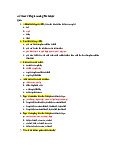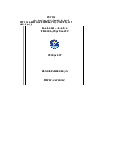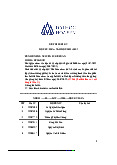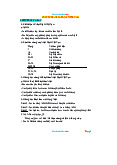







Preview text:
REVIEW FOR MID-TEST RISK
1. ABC Bus Corporation provides school bus transportation to public schools
in Orange County. ABC Bus owns 50 buses that are garaged in three
different cities within the county. The firm faces competition from two
larger bus companies that operate in the same area. Public school boards
generally award contracts to the lowest bidder, but the level of service and
overall performance is also considered.
a. Identify the major loss exposures faced by ABC Bus.
b. For each of the loss exposures identified in (a), identify a risk
management technique or combination of techniques that could be used to handle the exposure. -
Buses may get an accident partially/ totally d amaged
insurance (car/bus), retention, loss prevention (drivers drive carefully, take
extra lesson of driving, do not drink, have enough sleep,…) -
Buses may cause damage/ death to pedestrians or another drivers. Buses may
cause damage to another cars/ buses/ motorcycles.
insurance (liabilities), loss prevention -
Loss of business income (due to the competition)
business income insurance, retention, loss prevention (new school, reduce profit get lower price) -
Employees may be sick/ accident/ injured
insurance (health), loss prevention -
Garages may be damaged by theft, fire, accident, natural disasters
insurance (property), retention - Students may be injured
insurance (liabilities), loss prevention
2. Several types of risk are present in the American economy. For each of the
following, identify the type of risk that is present. Explain your answer -
The Department of Homeland Security alerts the nation of a possible attack by terrorists. Non-diversifiable -
A house may be severely damaged in a fire Pure risk -
A family head may be totally disabled in a plant explosion. Pure risk -
An investor purchases 100 shares of Microsoft stock Speculative risk -
A river that periodically overflows may cause substantial property damage to
thousands of homes in the floodplain Non-diversifiable -
Home buyers may be faced with higher mortgage payments if the Federal
Reserve raises interest rates at its next meeting Diversifiable risk -
A worker on vacation plays the slot machines in a casino Speculative risk
3. There are several techniques available for managing risk. For each of the
following risks, identify an appropriate technique, or combination of
techniques, that would be appropriate for dealing with the risk. -
A family head may die prematurely because of a heart attack. loss prevention, insurance -
An individual’s home may be totally destroyed in a hurricane insurance, loss prevention, retention -
A new car may be severely damaged in an auto accident insurance, loss
prevention, loss reduction, retention -
A negligent motorist may be ordered to pay a substantial liability judgment to
someone who is injured in an auto accident insurance (liabilities insurance) -
A surgeon may be sued for medical malpractice insurance (liabilities insurance), loss prevention INTRODUCTION TO DERIVATIVES
1. (Slide 11) An investor with $2,000 to invest feels that a stock price will
increase over the next 2 months. The current stock price is $20 and the
price of a 2-month call option with a strike of 22.50 is $1. What are the alternative strategies? - Buying 100 shares -
Buying 20 calls (on 100 shares each)
2. (Slide 12) A stock price is quoted as £100 in London and $150 in New
York The current exchange rate is 1.5300 What is the arbitrage opportunity? -
Buy 100 shares in NY; sell 100 in London -
100 [(1.5300 x 100) – 150] = 300
3. (Slide 31) On May 6, 2013, the treasurer of a corporation enters into a
long forward contract to buy £1 million in six months at an exchange
rate of 1.5532. This obligates the corporation to pay $1,553,200 for £1
million on November 6, 2013. What are the possible outcomes? -
Using the quotes in the table, the treasurer can agree to buy £1 million 6 months
forward at an exchange rate of 1.5532. The corporation then has a long forward
contract on GBP. It has agreed that on November 6, 2013, it will buy £1 million
from the bank for $1.5532 million. The bank has a short forward contract on
GBP. It has agreed that on November 6, 2013, it will sell £1 million for $1.5532
million. Both sides have made a binding commitment.
FORWARDS & FUTURES CONTRACTS
1. (Slide 52) Manohar has just taken a long position in a futures contract
for 100 ounces of gold to be delivered in January. Magda has just taken
a short position in the same contract. The futures price is $380 per
ounce. The initial margin requirement is 10%. What is Manohar’s
initial margin requirement? What is Magda’s initial margin requirement? -
Manohar’s initial margin requirement is the same with Magda’s -
Value of contract: 100*380 = 38000$ -
Margin requirement: 10% = 3800$
2. (Slide 53) Consider Manohar (who is long) and Magda (who is short) in
the contract for 100 ounces of gold. At the beginning of the day, the
contract specified a price of $380 per ounce at the end of the day, the
futures price has risen to $385 so the contracts are rewritten
accordingly. ◦ What is the effect of marking to market for Manohar (long)?
◦ What would be the effect on Magda (short)?
◦ What would have happened if the futures price had dropped by $10
instead of rising by $5 as described above? - Manohar: long positionbuyer - Magda: short positionseller - Begin: $380 End: $385 -
Manohar: get profit (vì giá mua ban đầu là 380, Manohar sẽ chỉ mua với giá
đã kí thỏa thuận là 380, trong khi đó giá thị trường là 385). Get profit: 385- 380 = 100*5 = $500 -
Magda: get loss (vì giá bán ban đầu khi kí thỏa thuận là 380, hiện tại giá
bán thị trường là 385). Get loss: $500 -
Long position (người mua) sẽ có lợi nhuận khi giá thị trường tăng so với giá ban đầu -
Short position (người bán) sẽ có lợi nhuận khi giá của thị trường giảm so với giá ban đầu -
The futures price had dropped by 10$, seller (Magda) get profit, buyer
(Manohar) get loss. Profit or loss: 380 – 370 = 10*5 = $50 3.
(Slide 55) A company enters into a short futures contract to sell 5,000
bushels of wheat for 450 cents per bushel. The initial margin is $3,000 and
the maintenance margin is $2,000. What price change would lead to a
margin call? Under what circumstances could $1,500 be withdrawn from the
margin account? What are the cumulative effects of marking to market? -
Balance of margin level is ≤ than maintenance margin asking for margin call - Requirement margin = 3000 - Maintenance margin = 2000 -
Margin loss: 3000-2000=1000 is equivalent to 5000 bushels of wheat -
The loss of each bushels of wheat: 1000/5000 = 0.2$ -
Price must go up to 4.5+0.2=4.7 or higher mar gin call
4. (Slide 94) A 1-year long forward contract on a non-dividend paying
stock is entered into when the stock price is $40 and the risk-free rate of
interest is 10% per annum with continuous compounding.
(a) What are the forward price and the initial value of the forward contract?
(b) (b) Six months later, the price of the stock is $45 and the risk-free
interest rate is still 10%. What are the forward price and the value of the forward contract? -
Forward price: Fo = So.e^rT = 40*e^0.1*1=44.21
(b) So = 45, r = 0.1 T = 6/12 = 0.5 - Fo = So.e^rT = 47.31 -
Value of contract: f = So – F.e^-rT = 2.2
5. (Slide 95) On June 9 of a particular year, the spot rate for dollars was
0.7908 euros. The U.S. interest rate was 5.84 percent, while the euro
interest rate was 3.59 percent. The time to expiration is 90 days.
Calculate its forward price in this case. -
F = 0.7908 x 1.0584^-90/365 x 1.0359^90/365 = 0.786 REVIEW
1. (Slide 12) An investor enters into a short forward contract to sell
100,000 British pounds for US dollars at an exchange rate of 1.4000 US
dollars per pound. How much does the investor gain or lose if the
exchange rate at the end of the contract is (a) 1.3900 and (b) 1.4200? -
A. Gain: (1.4 – 1.39)*100000 = 1000 -
B. Loss: (1.4 – 1.42)*100000 = -2000
2. (Slide 12) A trader enters into a short cotton futures contract when the
futures price is 50 cents per pound. The contract is for the delivery of
50,000 pounds. How much does the trader gain or lose if the cotton
price at the end of the contract is (a) 48.20 cents per pound and (b) 51.30 cents per pound? -
A. Gain: (50 – 48.2)*50000 = 900 -
B. Loss: (50 – 51.3)*50000 = -650
3. (Slide 13) On July 1, 2011, a company enters into a forward contract to
buy 10 million Japanese yen on January 1, 2012. On September 1, 2011,
it enters into a forward contract to sell 10 million Japanese yen on
January 1, 2012. Describe the payoff from this strategy. -
Suppose that the forward price for the contract entered into on July 1, 2011 is
F1 and that the forward price for the contract entered into on September 1, 2011
is F2 with both F1 and F2 being measured as dollars per yen. If the value of one
Japanese yen (measured in US dollars) is S(T) on January 1, 2012, then the
value of the first contract (in millions of dollars) at that time is: 10*( S −F T 1 )
while the value of the second contract at that time is: 10*( F −S 2 T ) -
The total payoff from the two contracts is therefore: 10(S −F −S − T 1 )+10 (F 2 T )=10 (F F 2 1 ) -
Thus, if the forward price for delivery on January 1, 2012 increased between
July 1, 2011 and September 1, 2011 the company will make a profit. (Note that
the yen/USD exchange rate is usually expressed as the number of yen per USD
not as the number of USD per yen
4. (Slide 13) A US company knows it will have to pay 3 million euros in 3
months. The current exchange rate is 1.4500 dollars/euro. Discuss how
forwards and options contracts can be used by the company to hedge its exposure. -
The current exchange rate is 1.4500 dollars/euro. Hence, 3 million euros would
need to be paid in 4.35 million USD. -
There are two things that could happen: (i) The exchange rate goes up and euros
cost a lot more to buy then. (ii) The exchange rate goes down and euros are cheaper. -
We need not worry about the good scenario (ii). Rather, the question is how to
hedge our exposure to the risk of the exchange rate going up? -
We could go into a forward contract to buy the euro at a prespecified exchange
rate. So, sure the spot exchange rate at that time could be lower, but we could
eliminate the risk of it being much higher. -
We could also buy call options and have the right without the obligation to
purchase euros at a predetermined strike price. It would cost us a set premium,
but it would put an acceptable bound to our losses from exchange rate
fluctuation. ON other hand, we get the upside if the exchange rate fluctuates incur favor.
5. (Slide 14) Suppose that in September 2012 a company takes a long
position in a contract on May 2013 crude oil futures. It closes out its
position in March 2013. The futures price (per barrel) is $68.30 when it
enters into the contract, $70.50 when it closes out its position, and
$69.10 at the end of December 2012. One contract is for the delivery of
1,000 barrels. What is the company’s total profit? When is it realized?
How is it taxed if it is (a) a hedger and (b) a speculator? Assume that the
company has a December 31 year-end. - Giá ban đầu: 68.30 Giá kết thúc: 70.50 -
Tính total profit: Lấy kết thúc trừ giá ban đầu -
Giá được ghi nhận từng ngày: tính giá chênh lệch từng ngày, lấy giá trước trừ giá sau -
Total profit: (70.50 – 68.30)*1000 = $2200 -
(69.10 – 68.30)*1000 = $800 is realized on a day-by-day between September, 2012 and December 31, 2012 -
(70.50 – 69.10)*1000 = 1400 is realized on a day-by-day basis between January 1, 2013, and March 2013. -
A hedger would be taxed on the whole profit of $2,200 in 2013. A speculator
would be taxed on $800 in 2012 and $1,400 in 2013.
6. (Slide 15) A trader buys two July futures contracts on orange juice.
Each contract is for the delivery of 15,000 pounds. The current futures
price is 160 cents per pound, the initial margin is $6,000 per contract,
and the maintenance margin is $4,500 per contract. What price change
would lead to a margin call? Under what circumstances could $2,000 be
withdrawn from the margin account? -
There is a margin call if more than $1,500 is lost on one contract. This happens
if the futures price of frozen orange juice falls by more than 10 cent to below
150 cent per pound. $2,000 can be withdrawn from the margin account if there
is a gain on one contract of $1,000. This will happen if the futures price rises by
6.67 cents to 166.67 cents per pound. -
Requirement margin: 6000 -
Maintenance margin: 4500 -
The margin call if more than: 6000 - 4500 = 1500 equivalent to 15000 pounds -
The loss of each bushels: 1500/15000 = 0.1$ = 10 cent -
Price must down to 160 – 10 = 150 cent
7. (Slide 16) A cattle farmer expects to have 120,000 pounds of live cattle
to sell in 3 months. The live cattle futures contract traded by the CME
Group is for the delivery of 40,000 pounds of cattle. How can the farmer
use the contract for hedging? From the farmer’s viewpoint, what are
the pros and cons of hedging? -
The farmer can short 3 contracts that have 3 months to maturity. If the price of
cattle falls, the gain on the futures contract will offset the loss on the sale of the
cattle. If the price of cattle rises, the gain on the sale of the cattle will be offset
by the loss on the futures contract. Using futures contracts to hedge has the
advantage that it can at no cost reduce risk to almost zero. Its disadvantage is
that the farmer no longer gains from favorable movements in cattle prices.
8. (Slide 17) Trader A enters into futures contracts to buy 1 million euros
for 1.4 million dollars in three months. Trader B enters in a forward
contract to do the same thing. The exchange rate (dollars per euro)
declines sharply during the first two months and then increases for the
third month to close at 1.4300. Ignoring daily settlement, what is the
total profit of each trader? When the impact of daily settlement is taken
into account, which trader has done better? -
The total profit of each trader in dollars is 0.03×1,000,000 = 30,000. Trader B’s
profit is realized at the end of the three months. Trader A’s profit is realized day-
by-day during the three months. Substantial losses are made during the first two
months and profits are made during the final month. It is likely that Trader B
has done better because Trader A had to finance its losses during the first two months.
9. (Slide 18) A company has a $20 million portfolio with a beta of 1.2. It
would like to use futures contracts on the S&P 500 to hedge its risk. The
index futures price is currently standing at 1080, and each contract is
for delivery of $250 times the index. What is the hedge that minimizes
risk? What should the company do if it wants to reduce the beta of the portfolio to 0.6? -
The number of contracts: 1.2 x 20,000,000 = 88.9 1080× 250 -
Rounding to the nearest whole number, 89 contracts should be shorted. To
reduce the beta to 0.6, half of this position, or a short position in 44 contracts, is required
10. (Slide 20) The standard deviation of monthly changes in the spot price
of live cattle is (in cents per pound) 1.2. The standard deviation of
monthly changes in the futures price of live cattle for the closest
contract is 1.4. The covariance between the futures price changes and
the spot price changes is 0.7. It is now October 15. A beef producer is
committed to purchasing 200,000 pounds of live cattle on November 15.
The producer wants to use the December live cattle futures contracts to
hedge its risk. Each contract is for the delivery of 40,000 pounds of
cattle. What strategy should the beef producer follow? -
The optimal hedge ratio is: 0.7 x 1.2 = 0.6m 1.4 -
The beef producer requires a long position in 200000*0.6 = 120,000 lbs of
cattle. The beef producer should therefore take a long position in 3 December
contracts closing out the position on November 15.
11. (Slide 21) On July 1, an investor holds 50,000 shares of a certain stock.
The market price is $30 per share. The investor is interested in hedging
against movements in the market over the next month and decides to
use the September Mini S&P 500 futures contract. The index futures
price is currently 1,500 and one contract are for delivery of $50 times
the index. The beta of the stock is 1.3. What strategy should the investor
follow? Under what circumstances will it be profitable? × -
A short position: 1.3 x 50000 30 = 26 contracts is required. It will be 50×1500
profitable if the stock outperforms the market in the sense that its return is
greater than that predicted by the capital asset pricing model
12. (Slide 22) Suppose that you enter into a 6-month forward contract on a
non-dividend-paying stock when the stock price is $30 and the risk-free
interest rate (with continuous compounding) is 12% per annum. What is the forward price? -
The forward price: 30 e0.12×0.5 = 31.86
13. (Slide 22) A stock index currently stands at 350. The risk-free interest
rate is 8% per annum (with continuous compounding) and the dividend
yield on the index is 4% per annum. What should the futures price for a 4- month contract be? -
The future price is: 350 e(0.08−0.04)×4/12=¿ 354.7
14. (Slide 23) A 1-year long forward contract on a non-dividend paying
stock is entered into when the stock price is $40 and the risk-free rate of
interest is 10% per annum with continuous compounding.
(a) What are the forward price and the initial value of the forward contract?
(b) Six months later, the price of the stock is $45 and the risk-free interest
rate is still 10%. What are the forward price and the value of the forward contract? -
The forward price is: F =¿ × 0
40 e0.1 1 = 44.21. The value of contract is 0 -
The forward price after 6 months: 45 e0.1×0.5 = 47.31. The value of
contracts: f = 45 – 44.21 e−0.1×0.5 = 2.95
15. (Slide 24) The risk-free rate of interest is 7% per annum with
continuous compounding, and the dividend yield on a stock index is
3.2% per annum. The current value of the index is 150. What is the 6- month futures price? -
Future price after 6 months: 150 e(0.07−0.032) ×0.5 = 152.88
16. (Slide 25) Assume that the risk-free interest rate is 9% per annum with
continuous compounding and that the dividend yield on a stock index
varies throughout the year. In February, May, August, and November,
dividends are paid at a rate of 5% per annum. In other months,
dividends are paid at a rate of 2% per annum. Suppose that the value of
the index on July 31 is 1,300. What is the futures price for a contract
deliverable in December 31 of the same year? -
The average dividend yield: 1/5*(3*2+2*5) = 3.2% -
The future price: 1300 e(0.09−0.032)×0.4167 = 1331.80$
17. (Slide 26) The 2-month interest rates in Switzerland and the United
States are, respectively, 2% and 5% per annum with continuous
compounding. The spot price of the Swiss franc is $0.8000. The futures
price for a contract deliverable in 2 months is $0.8100. What arbitrage
opportunities does this create? -
The theoretical future price: 0.8 e(0.05−0.02)×2/12 = 0.8040 -
The actual futures price is too high. This suggests that an arbitrageur should buy
Swiss francs and short Swiss francs futures.




